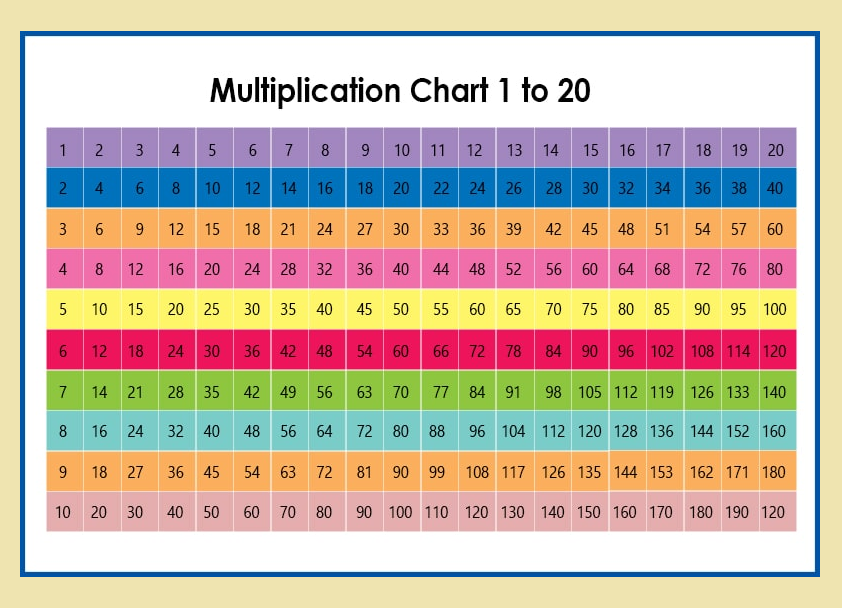Multiplication is a cornerstone of mathematics, and mastering it opens the door to understanding advanced math concepts like division, algebra, and geometry. A multiplication chart 1-20 is an excellent tool for learners who want to go beyond the basics and strengthen their math skills. Whether you’re a student, a teacher, or a parent, this chart is a powerful resource for learning and exploration.
What is a Multiplication Chart 1-20?
A multiplication chart 1-20 is a grid that displays the products of numbers from 1 to 20. The numbers 1 through 20 are listed along the top row and the left column. The intersecting cell shows the product of the corresponding row and column numbers.
For example:
- To find 13 x 7, locate 13 in the left column and 7 in the top row. The intersection of these two numbers gives the product: 91.
Why Use a Multiplication Chart 1-20?
- Expanded Learning
A 1-20 chart extends beyond the traditional 1-10 or 1-12 charts, helping learners tackle larger numbers. It’s especially useful for middle school students and those aiming to improve their math fluency. - Recognizing Patterns
With a larger range, students can observe patterns and relationships between numbers, such as:- The diagonal cells represent perfect squares (e.g., 4×4 = 16, 15×15 = 225).
- Multiples of 5 always end in 0 or 5.
- Rows and columns of even numbers only contain even products.
- Preparing for Advanced Math
Learning multiplication beyond 1-12 builds a stronger foundation for advanced topics, such as fractions, ratios, and exponents, which often involve larger numbers. - Practical Applications
A 1-20 chart is useful in real-world situations, such as calculating areas, understanding proportions, and solving complex math problems that require larger multiplication facts.
How to Use a Multiplication Chart 1-20 Effectively
- Start with Familiar Numbers
Focus on smaller numbers, such as 1-10, before expanding to larger ranges like 11-20. - Break it Into Sections
Divide the chart into smaller chunks (e.g., 1-10 and 11-20). Master each section separately before putting it all together. - Practice Regularly
Dedicate a few minutes daily to reviewing the chart. Repetition helps solidify memory and improve speed. - Look for Patterns
Encourage students to spot patterns. For example, the row for 10 is simply the other number multiplied by 10 (e.g., 10×3 = 30, 10×14 = 140). - Combine with Exercises
Use the chart alongside multiplication games, flashcards, or quizzes to make learning engaging and interactive.
Benefits of a 1-20 Multiplication Chart
- Improved Math Fluency: It helps learners quickly recall larger multiplication facts.
- Boosts Confidence: Mastering a wider range of numbers builds confidence for tackling advanced math problems.
- Versatility: The chart can be used for a variety of math topics, including area calculation and solving equations.
Printable Multiplication Charts 1-20
Printable charts are widely available online. Some versions include:
- Filled Charts: Useful for quick reference and pattern recognition.
- Blank Charts: A great practice tool for learners to fill in products on their own.
- Color-Coded Charts: Highlight even numbers, odd numbers, or perfect squares to make patterns easier to identify.
Real-Life Applications
A 1-20 multiplication chart isn’t just for classroom use. It’s also helpful for:
- Construction and Engineering: Calculating dimensions and materials for projects.
- Science Experiments: Working with larger datasets.
- Everyday Math: Budgeting, shopping, and understanding measurements.
Conclusion
The multiplication chart 1-20 is a step up from traditional charts, offering a comprehensive tool for learning and application. It challenges learners to go beyond the basics and equips them with the skills to handle larger numbers confidently.
Whether you’re a student aiming to excel in math, a teacher seeking effective teaching aids, or a parent supporting your child’s learning journey, the 1-20 chart is a versatile and valuable resource.
So grab a multiplication chart 1-20, start practicing, and discover how it can transform your math skills!




Leave a Reply